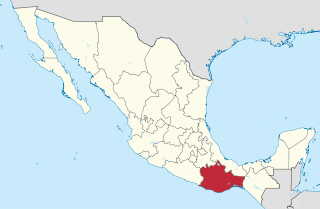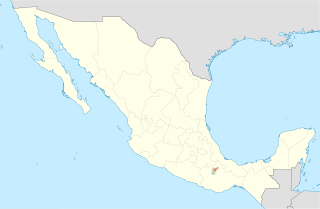
Oaxaca, officially the Free and Sovereign State of Oaxaca, is one of the 32 states that compose the Federative Entities of the United Mexican States. It is divided into 570 municipalities, of which 418 are governed by the system of usos y costumbres with recognized local forms of self-governance. Its capital city is Oaxaca de Juárez.

Porophyllum ruderale is an herbaceous annual plant whose leaves can be used for seasoning food. The taste has been described as "somewhere between arugula, cilantro and rue". The plant is commonly grown in Mexico and South America for use in salsas. When fully grown, the plant measures about 150 cm (5 ft) in height and 90 cm (3 ft) in diameter.

The cemita is a torta originally from Puebla, Mexico. Also known as cemita poblana, it derives from the city of Puebla. The word refers to the sandwich as well as to the roll it is typically served on, a bread roll covered with sesame seeds. Additionally, the ingredients usually are restricted to sliced avocado, meat, Oaxaca cheese, onions, the herb pápalo and chipotle adobado, or jalapeño.

Cuicatec is an Oto-Manguean language spoken in Oaxaca, Mexico. It belongs to the Mixtecan branch together with the Mixtec languages and the Trique language. The Ethnologue lists two major dialects of Cuicatec: Tepeuxila Cuicatec and Teutila Cuicatec. Like other Oto-Manguean languages, Cuicatec is tonal.
Thorius papaloae, commonly known as the Papalo minute salamander, is a species of salamander in the family Plethodontidae. It is endemic to Mexico and only known from one locality near the village of Concepción Pápalo in Sierra Juárez, Oaxaca.

Homoeocera is a genus of moths in the subfamily Arctiinae The genus was erected by Cajetan Felder in 1874.
Santos Reyes may refer to:
Concepción Pápalo is a town and municipality in Oaxaca in south-western Mexico. The municipality covers an area of 94.4 km2. It is part of Cuicatlán District in the north of the Cañada Region.
Santa María Pápalo is a town and municipality in Oaxaca in south-western Mexico. The municipality covers an area of km². It is part of Cuicatlán District in the north of the Cañada Region.
Santos Reyes Pápalo is a town and municipality in Oaxaca in south-western Mexico. The municipality covers an area of km². It is part of Cuicatlán District in the north of the Cañada Region.

Homoeocera gigantea is a moth of the subfamily Arctiinae first described by Herbert Druce in 1884. It is found from Guatemala to Costa Rica, generally at high altitude in very humid biotopes. It is not presently known from Nicaragua, possibly because collecting at high altitude is difficult due to the topography of the country.

Homoeocera georginas is a moth of the subfamily Arctiinae. It is known only for a restricted area in Guatemala, on the Pacific slope, at high altitude.

Cuicatlán District is located in the south of the Cañada Region of the State of Oaxaca, Mexico. The district includes 20 municipalities, bringing together a total of 233 settlements.
According to the Mexican government agency Conapo, Oaxaca is the third most economically marginalized states in Mexico. The state has 3.3% of the population but produces only 1.5% of the GNP. The main reason for this is the lack of infrastructure and education, especially in the interior of the state outside of the capital. Eighty percent of the state's municipalities do not meet federal minimums for housing and education. Most development projects are planned for the capital and the surrounding area. Little has been planned for the very rural areas and the state lacks the resources to implement them. The largest sector of Oaxaca's economy is agriculture, mostly done communally in ejidos or similar arrangements. About 31% of the population is employed in agriculture, about 50% in commerce and services and 22% in industry. The commerce sector dominates the gross domestic product at 65.4%, followed by industry/mining at 18.9% and agriculture at 15.7%.
Homoeocera rodriguezi is a moth of the subfamily Arctiinae first described by Herbert Druce in 1890. It is found in Mexico, Guatemala and Costa Rica.
Homoeocera toulgoeti is a moth of the subfamily Arctiinae first described by Xavier Lesieur in 1984. It is found in Ecuador.
Homoeocera multipuncta is a moth of the subfamily Arctiinae. It is found in Brazil.
Homoeocera magnolimbata is a moth of the subfamily Arctiinae. It is found in French Guiana.

The Euchromiina are a subtribe of tiger moths in the family Erebidae. It was described by Arthur Gardiner Butler in 1876. Many species in the subtribe are mimics of wasps. Euchromiina have always been considered closely related to the subtribe Ctenuchina due to their similarity to moths and wasps. These two subtribes make up around 3,000 valid species, the majority of which occur in the Neotropics.
The following television stations broadcast on digital channel 23 in Mexico:








